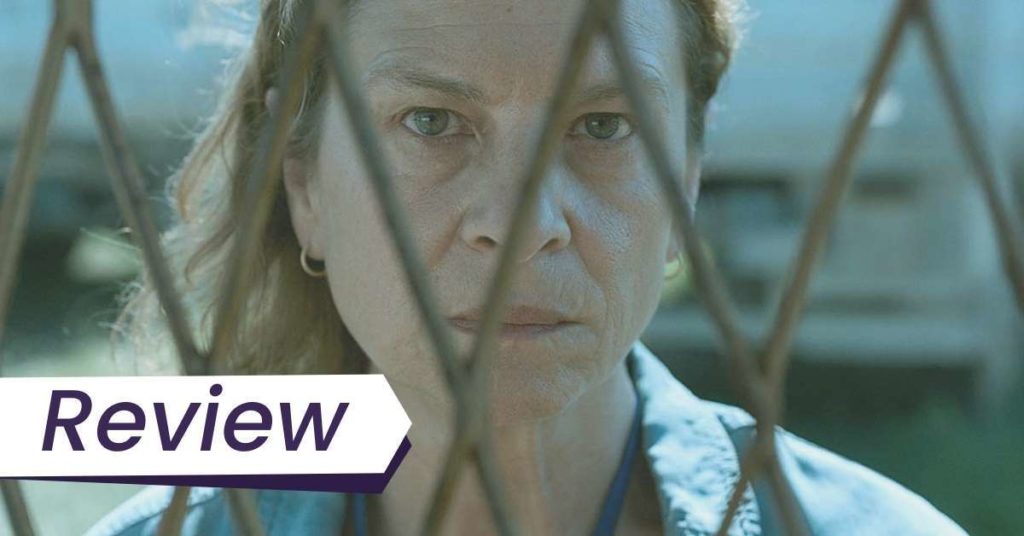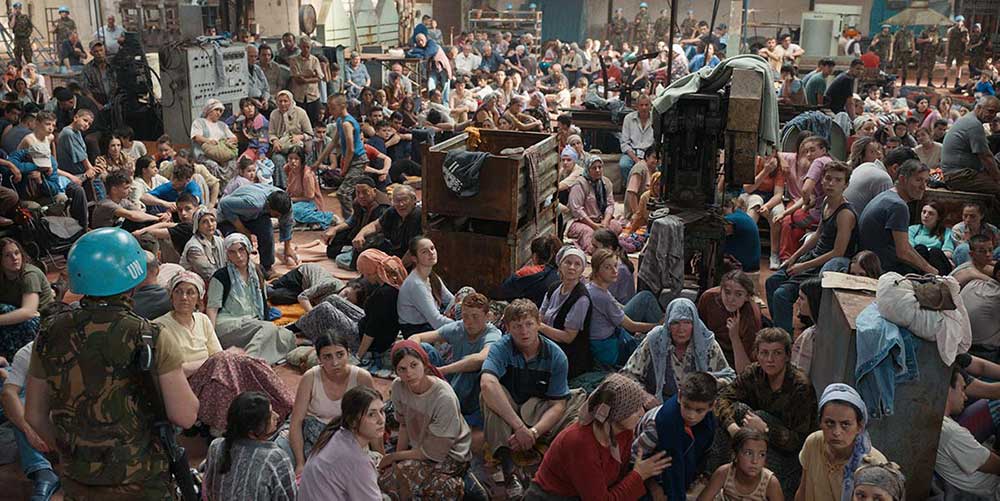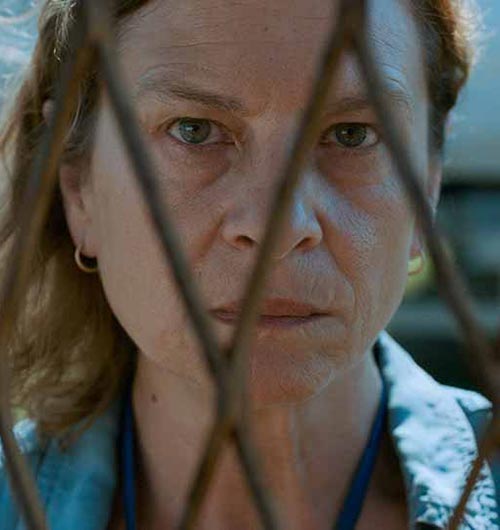Orla Smith’s review of Jasmila Žbanic’s Quo Vadis, Aida?, a harrowing drama about the 1995 Bosnian genocide, and one of the best films of TIFF 2020. Keep up to date with our TIFF ’20 coverage.

It was a while into the first scene of Quo Vadis, Aida? before I realised that Jasna Ðuricic’s fierce lead character, Aida, was a translator. Facilitating a discussion between the mayor of her hometown, Srebrenica in Bosnia, and a pair of Dutch UN soldiers, she spends the scene simply relaying the words of the men in the room, but Ðuricic makes her opinions of the men’s decisions so clear that she could easily be mistaken for a participant. She shifts in her seat, her gaze set in a worried scowl, her eyes shifting restlessly between everyone in the room. She and the mayor exchange knowing looks as if silently communicating. When she translates, she speaks quickly in a stern tone, rushing the conversation along because she knows how urgent the matters being discussed are. Impartial translation is pretty much impossible in any case — you’re always adapting words and phrasing through your own lens — but especially for Aida, a citizen of wartorn Srebrenica.
This is 1995, in the heat of the war between the Serbian and Bosnian populations, and the Serbs are encroaching on Srebrenica in increasingly violent ways. Writer-director Jasmila Žbanic, who lived through the war, drops us straight into the action with this scene of negotiation between the mayor, who is concerned for the safety of his townspeople, and the UN soldiers, who assure him that the Serbs “have been issued an ultimatum” that will keep Srebrenica safe. Through Aida’s panicked eyes, we watch this hopeless conversation unfold as the soldiers naively reason that the Serbs won’t attack because the UN has warned that they will face “serious consequences” if they do.
This is the prologue to Quo Vadis, Aida?, a harrowing retelling of the genocide of the people of Srebrenica that grapples with the complicity of those who were ‘just doing their job.’ Although the film is brutal and disturbing, it refrains from showing us the most violent acts of the genocide, like the rapes and beheadings. Even when the mass genocidal slaughter occurs at the end of the film, Žbanic shows us the guns firing but not the bodies hitting the floor. She’s interested in who holds the power, not the spectacle of their violence.
In particular, she interrogates the actions of those whose job it was to protect the people of Srebrenica, and why, despite their best intentions, they failed to do so at every turn. Aida is a woman stuck between the worlds of the UN soldiers, who call the shots, and the helpless civilians, so through her eyes, the viewer has access to both the macro and the micro of the atrocities. As a school teacher who has been temporarily employed by the UN as a translator during the war, she belongs to the people. But she has more access to the military plans and the bigger picture than her peers. What’s more, the blue UN lanyard that’s always on her neck elevates her above her fellow civilians and ensures her safety.

As a survivor of war herself, Žbanic is deeply attuned to the way the people of Srebrenica are normalised to the horrors of war. There are no expository title cards at the beginning of Quo Vadis, Aida? explaining that Srebrenica has been under siege for two years. We immediately get that from the next scene: as bombs hit Srebrenica at night, Žbanic shows us Aida’s husband quickly but calmly picking up his notebook, glasses, and flask from a table and placing them in his pockets. Although his pace quickens at the sound of another bomb, he doesn’t panic in the way he would if this were new to him. One of his and Aida’s sons casually asks, “Can I borrow your sneakers?” as if there aren’t people dying outside their windows. Lingering on a shot of their now empty house, the camera creeps slowly through the darkened rooms, as if Žbanic is suggesting that they’ll never return, even though the characters don’t know it yet.
Žbanic portrays the UN’s failings as a failure to empathise: not being on the ground with the people leads to poor decisions, and as foreigners who speak a different language, even the Dutch UN officials are at a remove from the people their decisions affect. When the people of Srebrenica are shepherded to a UN shelter, their fate falls into the hands of UN officials who make all the decisions. Aida is their one access point to the people. Powerless to save her entire town, she is driven throughout the film by an unshakeable determination to get her husband and two sons to safety. But every time she tries to invoke pity from the UN officials, they fall back on blaming protocol for why they can’t save any one person over another, despite their visible sympathy.
Žbanic continually shows how the breakdown of communication between those witnessing an event and those at a distance causes poor decision-making. The only times the UN officials communicate with the townspeople, it’s at a remove: they stand on a stage elevated above the crowd, their words relayed (with Aida’s help) through a megaphone. Outside the base, when the Serbs arrive and demand to enter the ‘safe zone’ of the shelter, the decision of whether or not to let them in is dictated over a crackly intercom by an official who’s a couple of miles away. The poor sound quality out of the intercom, coupled with the hesitation in his speech, feels almost surreal — he’s so far away, clearly not sure of what he’s doing, but his words hold such fatal power. Because he doesn’t have to look those affected by his decision in the eye, he’s emboldened to allow the Serbs into the base. The official on the scene, who’s receiving these orders, initially riles against his colleague’s decision, looking visibly afraid of its implications. But because he can blame the decision on someone else and claim that he’s “just the piano player,” he’s emboldened to let the Serbs in.
By extension, Žbanic also asks us to question Aida’s complicity as the mouthpiece to the UN officials. Žbanic frames Aida in a two-shot with one of the UN officials as she translates his orders to the crowd of civilians. The two of them share equal space in the frame as if to suggest they are both complicit in what they’re about to do. Aida translates that the civilians should crowd onto the buses outside which the Serbians have promised will take them to safety — in reality, these buses take the Bosnian men and boys to their death. The civilians only know what they’re told, and given their compromised state — huddled together, near starving, and not thinking straight — they’re willing to trust a friendly face like Aida’s. But Aida knows, deep down, that her instructions have dealt the townspeople a death sentence: immediately after, she runs to hide her family so they don’t have to board the buses, too.

Become an expert on Quo Vadis, Aida?
Our resource page on Quo Vadis, Aida? is the invaluable resource on the film. Discover historical context, a director bio, link to all our articles and podcasts, and further reading.

